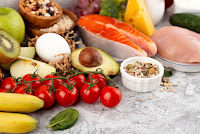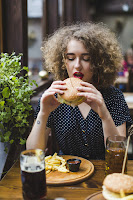Food-substance that promote development of an organism
General Deffinition of food
Food refers to any substance consumed by living organisms to provide nourishment and energy for growth, maintenance, and functioning. It can be of plant, animal, or microbial origin and is typically ingested through the mouth and digested in the digestive system to extract essential nutrients such as carbohydrates, proteins, fats, vitamins, and minerals. Food is an essential component of human life, and it plays a crucial role in sustaining health, supporting growth and development, and providing pleasure and enjoyment in the form of meals, snacks, and beverages. Food can also have cultural, social, and economic significance, and it varies widely in taste, appearance, texture, and nutritional composition across different cultures, regions, and cuisines.
Pic: bread/Food items, PhotoCredit: freepik.Table of Contents
What is food?
Food refers to any substance that is consumed by living organisms to provide nourishment and sustain life. It can be in the form of solid, liquid, or even gas, and is typically ingested through the mouth and digested in the gastrointestinal tract to release energy and essential nutrients that the body needs for growth, maintenance, and repair.
Classification
Food can be classified in various ways based on different criteria. Here are some common methods of classifying food: Pic: Classification of food, PhotoCredit: freepik.Food Groups:
Foods can be categorized into different food groups based on their nutritional characteristics. The most common food groups include:- Fruits and vegetables: Examples include apples, bananas, carrots, spinach, and broccoli.
- Grains: Examples include rice, bread, pasta, and cereals.
- Proteins: Examples include meat, poultry, fish, beans, lentils, tofu, and eggs.
- Dairy: Products include milk, cheese, yogurt, and butter.
- Fats and oils: Examples include vegetable oils, butter, margarine, and nuts.
- Sweets and desserts: Examples include sugar, candies, cakes, cookies, and ice cream.
Nutritional Content:
Foods can also be classified based on their nutritional content, such as:- Macronutrients: Foods can be classified as a source of carbohydrates, proteins, or fats based on their predominant macronutrient content. For example, rice and bread are primarily sources of carbohydrates, while meat and fish are sources of proteins, and oils and nuts are sources of fats.
- Micronutrients: Foods can be classified based on their vitamin and mineral content. For example, fruits and vegetables are typically rich in vitamins and minerals, while dairy products are a good source of calcium.
- Energy content: Classified as high-energy or low-energy foods based on their caloric content. For example, high-energy foods include fats, oils, and sugary foods, while low-energy foods include most fruits and vegetables.
Food Processing:
Foods can be classified based on the level of processing they undergo, such as:- Whole foods: These are foods that are minimally processed and retain their natural state, such as fresh fruits, vegetables, and unprocessed grains.
- Processed foods: These are foods that undergo some form of processing, such as cooking, drying, or freezing, but still retain much of their natural characteristics. Examples include canned fruits and vegetables, frozen fruits and vegetables, and dried beans.
- Ultra-processed foods: These are foods that are heavily processed and often contain added sugars, unhealthy fats, and artificial ingredients. Examples include fast food, packaged snacks, and sugary beverages.
Culinary Types:
Foods can be classified based on culinary types, such as:- Cuisines: Classified based on the culinary traditions and cuisines of different regions or countries, such as Italian cuisine, Indian cuisine, or Japanese cuisine.
- Cooking methods: Classified based on the cooking methods used to prepare them, such as grilled, baked, fried, boiled, or steamed foods.
Dietary Restrictions or Preferences:
Foods can be classified based on dietary restrictions or preferences, such as:- Vegetarian or vegan foods: These are foods that do not contain meat or animal products.
- Gluten-free foods: These are foods that do not contain gluten, a protein found in wheat, barley, and rye, which is avoided by those with celiac disease or gluten sensitivity.
- Halal or kosher foods: These are foods that are prepared and consumed according to specific dietary rules and requirements of Islamic or Jewish dietary laws, respectively.
Sources
Sources of food refer to the various ways in which food is obtained or produced. Here are some common sources of food: Photo:delicious-food-arrangement, Credit:freepik.Plants:
Many foods come from plants. Examples include fruits, vegetables, grains, legumes, nuts, seeds, and herbs. Plants are typically grown in agricultural fields, gardens, or orchards and harvested when they are mature and ready for consumption.Animals:
Animals are also a significant source of food. Examples include meat from mammals (such as beef, pork, and lamb), poultry (such as chicken and turkey), fish and seafood, eggs, and dairy products (such as milk, cheese, and yogurt). Animals can be raised for food through various methods, including farming, fishing, hunting, and aquaculture.Fungi:
Some foods come from fungi, such as mushrooms and truffles. These are usually harvested from the wild or cultivated in special conditions.Microorganisms:
Certain microorganisms are used in the production of food. For example, yeast is used in baking bread, brewing beer, and fermenting foods like yogurt and cheese. Bacteria are used in the production of fermented foods like sauerkraut, kimchi, and pickles.Insects:
In some cultures, insects are consumed as a food source. Examples include grasshoppers, crickets, mealworms, and ants. Insects are a rich source of protein and other nutrients and are considered a sustainable and environmentally friendly food source.Foraged or Wild Foods:
Some foods are obtained from the wild through foraging or gathering. Examples include wild mushrooms, berries, nuts, and edible plants. These foods are typically found in natural ecosystems and are harvested in their natural state.Processed Foods:
Processed foods are foods that have been altered or transformed from their original form. Examples include canned fruits and vegetables, frozen foods, dried foods, and processed meats. These foods are typically manufactured or processed to extend their shelf life, improve their taste or texture, or make them more convenient to consume.Food Products:
Food products are foods that have been processed or manufactured from raw ingredients. Examples include bread, pasta, breakfast cereals, canned soups, packaged snacks, and beverages. Food products are typically made by combining or processing different ingredients to create a final product that is ready to eat or drink.Synthetic or Lab-Grown Foods:
With advancements in food technology, there are also emerging sources of food that are produced using synthetic or lab-grown methods. Examples include lab-grown meat, plant-based meat alternatives, and genetically modified organisms (GMOs). These foods are created using scientific and technological methods to produce food-like substances that mimic the taste, texture, and nutritional content of traditional foods.Taste of food
The taste of food refers to the sensory experience we perceive when we consume food, including the flavors, textures, and aromas. Taste is a complex sensation that involves the interaction of our taste buds, which are located on the tongue, with the different components of food.
The five basic tastes commonly recognized by scientists are: Pic :Taste of food,freepik- Sweet: This taste is associated with the perception of sugars, such as those found in fruits, honey, and desserts. Sweet taste can also be artificially enhanced with the use of sweeteners.
- Sour: This taste is associated with the perception of acidity, such as that found in citrus fruits, vinegar, and fermented foods. Sour taste is often described as tangy or tart.
- Salty: This taste is associated with the perception of salt, such as that found in salted foods, processed snacks, and condiments. Salty taste is often described as savory or briny.
- Bitter: This taste is associated with the perception of bitterness, which can be found in foods like coffee, dark chocolate, leafy greens, and certain medicinal herbs. Bitter taste is often described as sharp or acrid.
- Umami: This taste is associated with the perception of savory or meaty flavors, often found in foods like meat, fish, mushrooms, and soy sauce. Umami taste is often described as rich or savory.
Digestion
Digestion is the process by which food is broken down into smaller molecules that can be absorbed and utilized by the body. It involves both mechanical and chemical processes that occur in the digestive tract, which includes the mouth, esophagus, stomach, small intestine, large intestine, and other associated organs.
The process of digestion can be broadly divided into several stages: Pic:food digestion, Photo Credit:freepik.- Ingestion: This is the process of taking food into the mouth and chewing it to break it down into smaller pieces that are easier to swallow. Saliva, produced by the salivary glands, begins the process of digestion by moistening the food and breaking down carbohydrates with the enzyme amylase.
- Swallowing: After food is chewed and mixed with saliva, it is swallowed and moves down the esophagus by muscle contractions called peristalsis. This propels the food towards the stomach.
- Stomach digestion: In the stomach, food is mixed with stomach acid and digestive enzymes, such as pepsin, to break down proteins into smaller peptides. The stomach also mechanically churns the food, further breaking it down into smaller particles called chyme.
- Small intestine digestion: The chyme moves into the small intestine, where most of the chemical digestion and absorption of nutrients occur. Enzymes from the pancreas, liver, and small intestine break down carbohydrates, proteins, and fats into their smaller building blocks, such as glucose, amino acids, and fatty acids. These nutrients are then absorbed into the bloodstream and carried to cells throughout the body for energy and other functions.
- Large intestine absorption: The remaining undigested food, water, and electrolytes pass from the small intestine to the large intestine (colon), where water and electrolytes are absorbed, and feces are formed.
- Elimination: Feces are eliminated from the body through the rectum and anus as waste.
Importance of food consumption
The consumption of food is of utmost importance for human survival and well-being. Food provides the body with essential nutrients, energy, and hydration that are necessary for growth, development, and maintenance of bodily functions. Here are some key reasons why food consumption is crucial:- Nutrient intake: Food is a primary source of essential nutrients, including carbohydrates, proteins, fats, vitamins, and minerals, that are necessary for the body to function properly. These nutrients play vital roles in various physiological processes, such as energy production, cell growth and repair, immune function, and brain function.
- Energy production: Food provides the body with the energy it needs to carry out physical activities and maintain basic bodily functions. Carbohydrates, proteins, and fats in food are broken down during digestion to release energy that is utilized by cells for various metabolic processes.
- Growth and development: Adequate food consumption is crucial for proper growth and development, especially during childhood, adolescence, and pregnancy. Nutrients obtained from food are essential for building and repairing tissues, bones, and organs, and for supporting the development of the brain and nervous system.
- Disease prevention: A healthy diet that includes a variety of nutrient-rich foods can help prevent various chronic diseases, such as heart disease, type 2 diabetes, certain cancers, and osteoporosis. A balanced diet that is rich in fruits, vegetables, whole grains, lean proteins, and healthy fats can provide the body with the necessary nutrients to support optimal health and reduce the risk of developing chronic diseases.
- Immune function: Proper nutrition is essential for a strong immune system, which plays a critical role in defending the body against infections and diseases. Nutrients obtained from food, such as vitamins A, C, D, and E, zinc, and selenium, are important for maintaining a healthy immune system.
- Cognitive function: The brain requires adequate nutrients and energy from food to function optimally. A balanced diet that includes nutrients such as omega-3 fatty acids, B vitamins, antioxidants, and other essential nutrients can support brain health and cognitive function, including memory, concentration, and mood.







Good information,,,
ReplyDeleteআপনার মূল্যবান মতামত জানানোর জন্য ধন্যবাদ ।
ReplyDelete